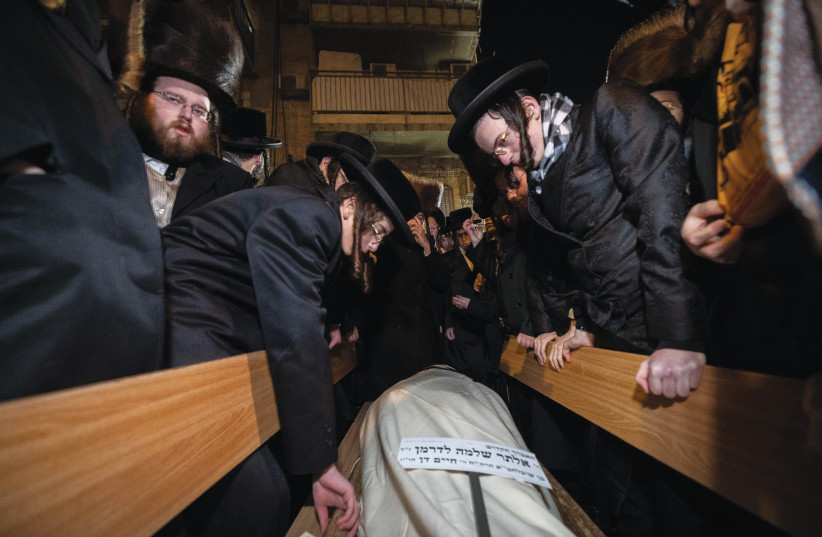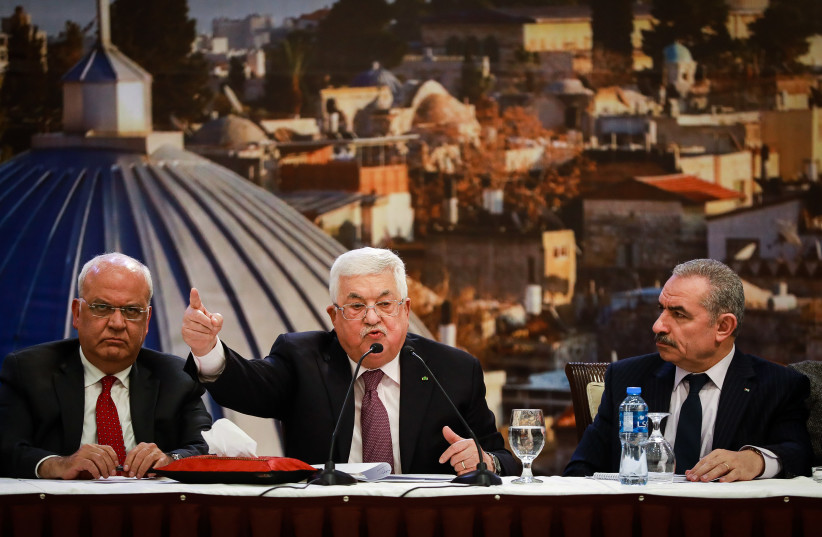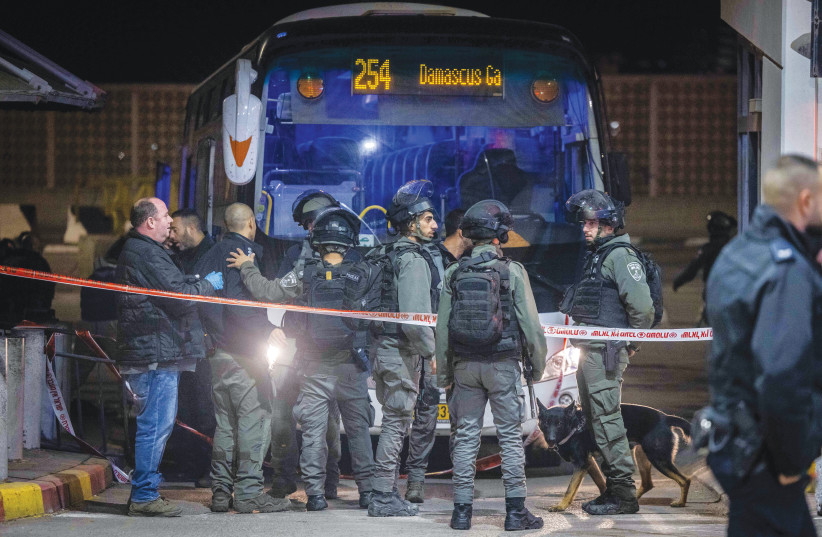by Seth J. Frantzman
This does not appear to be an era when terror groups feel they are on the rise, such as in the 1990s to 2014, when ISIS took over Mosul. Nevertheless, the violence continues.
 |
AT THE funeral of Alter Shlomo Lederman, 20, a newlywed yeshiva
student murdered in the car ramming near Jerusalem’s Ramot junction,
Feb. 11.
(photo credit: YONATAN SINDEL/FLASH90)
|
The recent increase in terror attacks in Jerusalem – which included two stabbings this week, one by a 14-year-old; last week’s car ramming; the Friday night shooting of congregants leaving a Neveh Ya’acov synagogue late last month; a shooting by a 13-year-old at the City of David that same day; and coordinated bombings at two bus stops in November – have catapulted the capital into the spotlight.
After every major act of terrorism, as the body count and number of wounded grow, some top media and international voices have referred to the attacks as part of a “cycle” – giving rise to concerns that a new intifada may be bubbling to the surface.
At the same time, the support for the attacks among Palestinians is concerning, although it is not a new phenomenon.
After last Friday’s car ramming at a Ramot bus stop, which killed three Israelis, including two young brothers, a reporter for Israel’s Channel 11 did some interviews near Damascus Gate, just outside the Old City. Unsurprisingly, some of those he interviewed said the Neveh Ya’acov attack should be praised and wished more Israelis would be killed.
On the one hand, we are supposed to be concerned by these comments; but on the other hand, decades of Palestinian incitement have led to a situation in which it is considered normal to openly praise attacks on civilians. One of the built-in problems with the Oslo Accords, as well as the peace with Jordan in the 1990s, was that Israel wanted an agreement and never demanded that as part of the peace deal, there would be coexistence.

In those days, it was seen as more important to have paperwork completed and some kind of a deal; an ideology similar to the Iran logic, which posited that a “deal” would somehow prevent war, even though the Islamic Republic kept waging war on the region and on the West.
Since we can’t go back in time, it’s only worth acknowledging that the kind of “peace” built into the “peace process,” Oslo and various “road maps” was one that guaranteed a return to violence, since it never required that educational institutions reduce incitement.
On the opposite side, it created an autonomous Palestinian Authority in the West Bank and Gaza that raised generations to celebrate when Israeli civilians are killed. Alongside them was a chorus of extremist supporters, some of them in the West, who created various excuses for this behavior, such as arguing that this is an armed struggle against apartheid and that Israeli civilians are actually combatants.
The most violent year in the West Bank since 2005
The last year has been described as the most violent in the West Bank since the UN began recording data on Israel-Palestinian clashes in 2005. It’s important to note here that this data point is well crafted to provide a headline because actually, the conflict is not more violent today than in conflicts such as the 2009 war in Gaza.
However, by looking solely at the West Bank, it is indeed violent. This has come about primarily due to the rise of Islamic Jihad in Jenin, gangs and militias in Nablus, as well as armed groups in Jericho. These seem to be men who are well armed thanks to arms trafficking in the West Bank.
The men all have M-16s, and while some may be relatives of members of Fatah or may have allegiance to Hamas or Palestinian Islamic Jihad (PIJ), the overall trend is that armed gangs and militias, mafias and militants are taking over one Palestinian city after another.
THE ARMS flow in the West Bank has gone on for decades, but recent years have apparently seen a surge in the flow of M-16s, the same type of rifle used by Israel and the US. Where do the weapons all come from? It’s not entirely clear, but the fact is that almost every Palestinian gunman killed in recent clashes with Israeli forces has been pictured with an M-16, usually in “martyr” photos published posthumously by supporters.
Attacks continue even with efforts to take the wind out of their sails
The M-16 generation of terrorist militias/gangs/mafias rising in the West Bank is a generation that was born after the Second Intifada began. That means they have no real memory of the brutal fighting that marked that era. They don’t remember the siege of the Muqata of the church in Bethlehem, the shooting from Beit Jala or the battle of Jenin.
They have only stories, and unlike the previous generations, they grew up entirely sealed off from Israel. This is because the security barrier was built when they were very young. Unlike their parents, they never met Israelis in a normal setting and didn’t likely work in Israel. They are the fruits of Oslo and the bizarre “peace” of the 1990s.
The fighters Israel is confronting and those involved in attacks today are also children of another phenomenon. They are not well trained because Israel dismantled the terror infrastructure of the late 1990s and early 2000s.
They also live under a Palestinian Authority whose security forces have been trained by US-backed programs. This is the US Security Coordinator program once called “Dayton’s Army.”
The other law-and-order aspect of the PA is provided by the EU-backed EUPOL COPPS. The clashes in Jenin, Nablus and Jericho over the last months reveal there is a critical issue emerging in the West Bank. Almost two decades of training Palestinian security forces and police, and building up institutions, has apparently not resulted in peace and security. Instead, the PA has retreated, and Israel is forced to go into the cities, either with quiet understanding with the PA and others, or not.
This means that any talk of an intifada must take into account how we got here. Israel has blockaded Gaza and neutralized Hamas threats over the years. Iran is not able to flood Gaza with the arms it was previously able to smuggle into the area. Iran is busy sending drones to Russia now, so it is more difficult to arm Gaza.
The Abraham Accords and other changes in the region also ostensibly should take the wind out of the sails of extremist groups. This does not appear to be an era when terror groups feel they are on the rise, such as in the 1990s to 2014, when ISIS took over Mosul. Nevertheless, the violence continues.
Even as groups like Al-Shabab are rolled back, and Egypt makes progress in the Sinai, and Israel hosts important forums with Arab countries, like the Negev Forum, there doesn’t seem to be peace here.
Support for a two-state solution is on the decline: Is there a way out?
AT THE same time, a recent poll shows declining support for a two-state solution among Israelis and Palestinians. However, this continues to lead to questions about the fact that neither seems to prefer any other way out of the impasse, either.
The Palestinian-Israeli Pulse joint poll was conducted by the Palestinian Center for Policy and Survey Research (PSR) in Ramallah, and the International Program in Conflict Resolution and Mediation at Tel Aviv University, with funding from the Netherlands Representative Office in Ramallah and the Representative Office of Japan to Palestine through UNDP/PAPP.

The joint poll was conducted in December, according to organizers, who announced the survey’s results on January 24. The findings indicate that “support for a two-state solution among Palestinians and Israelis declines to just one-third on each side, along with growing opposition to the detailed items of a permanent peace agreement for implementing a two-state solution.”
The poll shows that slightly more Israeli Jews support one unequal state under Israeli rule than the two-state solution, the report of the results said, “but both publics still prefer two states to any other democratic framework for resolving the conflict.”
There are other key findings, such as declining trust and the fact that “a majority of Palestinians reject four proposed confidence-building measures, while a majority of Israelis accept half of them.” The sample for the poll included Palestinians from the West Bank, Jerusalem and Gaza, as well as Israeli Jews and Arabs.
The survey shows that a large number of Palestinians, around 94%, “negate the idea that the land belongs to the other side.” For Israeli Jews, the number is 68%. It’s hard to understand how peace can be made under these circumstances. A majority of both sides also don’t think there is a peace partner on the other side.
But neither side has a viable idea of how to get out of this situation. “One non-democratic state ruled by Israel without equality for Palestinians is supported by 37% of Israeli Jews; one Palestinian state without equality for Jews is supported by 30% of Palestinians,” the survey notes.
“One non-democratic state ruled by Israel without equality for Palestinians is supported by 37% of Israeli Jews; one Palestinian state without equality for Jews is supported by 30% of Palestinians.”
Survey
THE OVERALL perception? There isn’t much that can build confidence on both sides.
This means the status quo will continue.
In terms of a new intifada, it would seem difficult for the Palestinians, who are divided and not well organized, to challenge Israel. However, that does not mean that attacks will not continue.

Since 2006 when Israel left Gaza and the last Palestinian elections brought Hamas to power in Gaza, there have been rounds of tensions and conflict generally centered on Jerusalem. This included the 2015-2016 “stabbing intifada” and the 2017 tensions over metal detectors, as well as disquiet in 2021 that led to a brief conflict.
It’s likely that a new type of low-level conflict could emerge. It is also very concerning that armed groups are influencing various cities which appear to be slipping away from PA control.
It would behoove international organizations to keep an eye on the weapons trafficking and gun violence, and examine how the weapons trade is eroding the PA’s control.
Seth J. Frantzman
Source: https://www.jpost.com/arab-israeli-conflict/article-731785
No comments:
Post a Comment